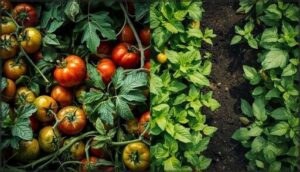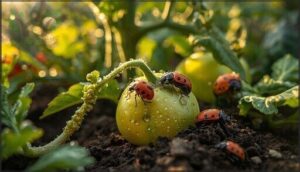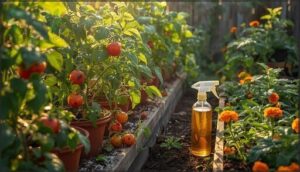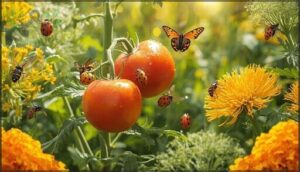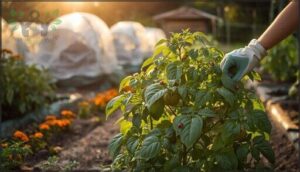This site is supported by our readers. We may earn a commission, at no cost to you, if you purchase through links.
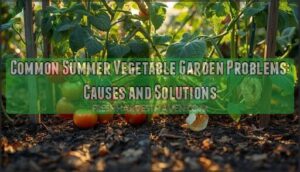
Your tomato plants looked perfect in June. Now their leaves curl and yellow while beetles strip your beans and your cucumbers won’t set fruit. Summer brings peak growing season but it also triggers a cascade of problems that can derail even experienced gardeners.
The shift from mild spring weather to summer heat stresses plants and creates conditions where pests, diseases, and cultural mistakes multiply fast. Most common summer vegetable garden problems stem from just five categories: compromised soil quality, watering errors, spacing mistakes, pest invasions, and environmental stress.
Recognizing these issues early and understanding their root causes lets you intervene before minor setbacks become total crop failures.
Table Of Contents
Key Takeaways
- Most summer vegetable garden failures stem from five core issues: depleted soil nutrients, inconsistent watering that stresses plants and attracts pests, overcrowding that blocks airflow and increases disease risk by 60%, pest invasions that can slash yields by 25%, and temperature extremes above 85°F that trigger blossom drop and fruit damage.
- Soil health determines everything above ground—without regular testing and amendments like compost, you won’t catch deficiencies until plants show visible damage, and pH imbalances outside the 6.0-7.5 range can cut yields by 33% even when nutrients are present.
- Proper plant spacing isn’t optional—crowded vegetables compete for resources so aggressively that photosynthesis drops 34%, disease rates jump 60%, and fruits grow 40% smaller than properly spaced plants that get adequate airflow and root space.
- Prevention beats reaction every time through mulching that doubles moisture retention while dropping soil temps 13°F, companion planting that attracts beneficial insects suppressing aphids by 80%, and physical barriers like row covers and shade cloth that eliminate pest access while moderating temperature swings before damage occurs.
Soil and Watering Problems in Summer Gardens
Your garden’s foundation starts beneath the surface. When soil lacks nutrients or water doesn’t reach roots consistently, plants struggle no matter how much sun they get.
Let’s look at the most common soil and watering problems that can derail your summer garden.
Poor Soil Quality and Nutrient Deficiencies
Depleted soil robs your vegetables of essential nutrients before they can thrive. Intensive growing strips organic matter from topsoil—sometimes losing up to 24% over several years. Without regular soil testing, you won’t spot deficiencies like boron or iron until plants show pale leaves and stunted growth. One major characteristic is low organic matter, which is detrimental to plant health.
Combat nutrient leaching with compost applications and biochar amendments. These rebuild soil health while improving water retention and plant nutrition naturally.
Soil PH Imbalances
Beyond nutrients, soil pH controls how well your plants can actually use what’s in the ground. Most summer vegetables need a range between 6.0 and 7.5 for best pH and nutrient uptake. A simple soil test reveals acidification risks that cut yields by 33% or more. Knowing the soil’s pH value is essential for nutrient absorption.
Correction methods include:
- Lime applications (2–8 tons/acre) to raise pH
- Elemental sulfur to lower high pH
- Variable amendments targeting problem zones
Fertilizer impact matters too—some products drop pH by 0.6 units in weeks.
Inconsistent Watering and Its Effects
Inconsistent watering creates more problems than any other irrigation issue in summer gardens. When you water erratically, plants develop stress responses that reduce yields by up to 30%. Tomatoes show blossom end rot from uneven calcium uptake.
Erratic watering stresses plants more than any other irrigation mistake, slashing yields by 30% and causing blossom end rot in tomatoes
Water-stressed plants also emit chemical signals that attract pests like cucumber beetles. Disease risk climbs too—irregular watering practices promote pathogen spread and extended leaf wetness on vulnerable crops.
Overwatering and Root Drowning
Overwatering drowns roots by reducing oxygen levels in the root zone by up to 85%. Root rot pathogens thrive in waterlogged soil, causing visible damage within 5–7 days. You might misread wilted leaves as drought when they signal oxygen depletion instead.
Drip irrigation reduces these irrigation issues by 60%, targeting water directly to root health needs without saturating the soil.
Benefits of Mulch and Compost
Mulch and compost transform struggling gardens into productive spaces through five key mechanisms. Mulched soil retains double the moisture of bare ground while staying up to 13 degrees cooler in summer heat.
- Moisture retention: Cut watering frequency by half through reduced evaporation
- Weed suppression: Block two-thirds of competing weeds automatically
- Nutrient cycling: Build soil health with slow-release organic matter that increases yields by 50%
These soil preparation practices improve watering practices naturally.
Planting and Spacing Mistakes to Avoid
Spacing your plants correctly makes the difference between a thriving garden and a struggling one. When plants don’t have enough room, they compete for everything they need to survive.
Here’s what happens when spacing goes wrong and how to fix it before disease and poor growth take over.
Overcrowding and Air Circulation Issues
When plants compete for the same square foot of soil, their foliage creates a dense canopy that blocks airflow. This stagnant environment invites trouble. Restricted air circulation increases fungal disease occurrence by up to 60%, while humid microclimates extend leaf wetness and accelerate pathogen spread. Poor ventilation also allows pest populations to thrive in the warmer conditions near crowded leaf surfaces.
| Overcrowding Impact | Measured Effect |
|---|---|
| Disease prevalence | 60% increase in fungal infections |
| Pest activity spread | 45% faster insect migration |
| Nutrient availability | 40% fewer accessible soil nutrients |
| Photosynthetic efficiency | 34% decrease in leaf rates |
| Drought resilience | 27% higher water loss rates |
Plant stress markers appear 40% more frequently in overcrowded plots. Your vegetables simply can’t breathe, leading to weakened immunity and reduced yields.
Ignoring Recommended Plant Spacing
Every crop has spacing guidelines based on its mature size and growth habits. When you skip those recommendations, you create resource competition that directly reduces yield impact across your vegetable garden. Here’s what happens:
- Tomatoes planted 12 inches apart produce 40% smaller fruits than those at proper 24-inch spacing
- Root vegetables cramped at 1-inch intervals develop stunted, misshapen produce
- Reduced airflow between tight rows increases disease risk by approximately 30%
- Poor harvest efficiency results when you can’t reach plants without damaging neighbors
Plant spacing determines plant health from germination through harvest.
Thinning Seedlings for Healthy Growth
You’ll see the biggest Growth Impact when you thin seedlings at 3-4 inches tall. This Thinning Timing prevents root entanglement while optimizing Resource Optimization through improved plant spacing.
Remove weaker seedlings to achieve two-inch Spacing Guidelines between survivors. This seedling care boosts plant health by reducing competition for nutrients and water in your vegetable garden.
Better airflow from proper plant growth also provides essential Disease Prevention against fungal pathogens.
Impact on Disease Susceptibility
Overcrowding effects go beyond stunted growth. Dense plantings trap moisture and create conditions where fungal diseases and bacterial diseases thrive.
Your crowded plants face up to 60% more disease risk due to poor air circulation and plant stress from competing for resources. Soil-borne diseases spread faster when roots touch, while increased insect activity introduces viral diseases.
Proper spacing is your best disease prevention strategy.
Common Summer Garden Pests and Damage
Nothing unravels a summer garden faster than an insect invasion. You might spot tiny holes in leaves, sticky residue on stems, or entire sections of plants wilting overnight.
Let’s walk through how to identify these unwelcome visitors and what you can do to protect your vegetables without reaching for harsh chemicals.
Identifying Insect Pests and Symptoms
Pest infestations start small but escalate quickly if you miss the signs. Learning to spot trouble early means the difference between a thriving crop and a total loss. Here are key indicators to watch for during your daily garden walks:
- Aphid identification: Look for clusters of tiny soft-bodied insects on new growth, causing curled yellow leaves and sticky honeydew residue
- Beetle damage: Check for chewed holes in foliage, scarred fruits, and skeletonized leaves from Colorado potato beetles or flea beetles
- Worm outbreaks: Inspect for irregular holes, severed seedlings at soil level, and frass near damaged plants
- Thrips symptoms: Notice silvery streaks, distorted leaves, and deformed flowers on peppers and onions
Pest monitoring through regular inspection catches problems before infestations reduce your yields by up to 25%.
Natural Pest Control Solutions
Once you’ve identified the problem, organic gardening offers multiple pest control strategies that work without synthetic chemicals. Neem oil disrupts insect hormones and controls over 200 garden pests, including aphids. Barrier methods like diatomaceous earth dehydrate soft-bodied insects on contact.
Biological agents such as Bacillus thuringiensis kill caterpillar larvae with 95% effectiveness. Combining these organic pesticides with companion planting and botanical solutions creates layered insect control that protects your harvest.
Attracting Beneficial Insects
Beyond chemical treatments, you can recruit nature’s own pest control team. Insectary plantings like marigolds, yarrow, and fennel attract lady beetles, lacewings, and parasitic wasps that naturally suppress aphid populations by up to 80%.
These predator habitats support sustainable design while improving garden yields. Planting diverse flowering species creates multi-layered insect control, achieving significant pesticide reduction without sacrificing your harvest to garden pests.
Preventing Pest Infestations
Prevention beats reaction every time. Crop rotation disrupts insect life cycles, while physical barriers like row covers exclude pests before damage begins.
Garden hygiene matters—remove plant debris harboring pest eggs. Companion planting with aromatic herbs deters insect pests naturally.
Apply organic pesticides such as neem oil when monitoring reveals early pest infestation. These integrated pest control methods protect your vegetables without constant chemical intervention.
Fungal and Bacterial Diseases in Vegetables
Summer heat and humidity create perfect conditions for fungal and bacterial diseases to thrive in your vegetable garden. These pathogens can quickly spread from plant to plant if you don’t recognize the warning signs early.
Let’s look at the most common diseases you’ll face and how to keep them from ruining your harvest.
Powdery Mildew Causes and Prevention
Powdery mildew thrives when fungal species find their sweet spot: warm days paired with cool nights and humidity between 70% and 95%. Spore dispersal happens through wind and insects, spreading quickly across your garden.
To stop fungal infections before they start:
- Space plants widely to boost airflow
- Water at soil level early in the day
- Choose resistant varieties when possible
- Apply sulfur-based fungicides preventively
Integrated management combining these strategies gives you real control over this common problem.
Early Blight Symptoms and Management
Early blight symptoms start as circular brown spots with distinctive concentric rings on lower leaves. These target-like patterns spread upward through the plant, potentially causing severe yield losses of up to 70% in tomatoes and potatoes.
Effective treatment combines fungicides like chlorothalonil with IPM strategies, including crop rotation and debris removal. Genetic resistance in newer varieties offers additional protection when paired with proper cultural practices.
Anthracnose and Rust in Summer Gardens
Among the most devastating fungal garden diseases, anthracnose and rust strike when you least expect them. High humidity and warm temperatures around 80°F trigger rapid fungal spread across your vegetables.
Disease identification and crop vulnerability matter:
- Anthracnose creates sunken black lesions on peppers, beans, tomatoes, and melons, causing up to 70% yield loss
- Rust produces pale spots with rust-colored pustules, repeating its cycle every 7-10 days
- Environmental factors like poor spacing increase infection rates beyond 50% in vulnerable crops
- Organic control includes neem oil and copper fungicides for effective treatment
Preventing Disease Spread Through Garden Hygiene
Tool disinfection stops disease transfer dead in its tracks. Soak your pruners in bleach solution or rubbing alcohol for one minute between cuts. Remove all plant debris, including roots and fallen leaves, to eliminate fungal hideouts.
Wash your hands before moving between plants, as viruses hitchhike on skin. Pull weeds that harbor pathogens and improve air circulation through proper spacing.
These preventative measures form your strongest disease management strategy.
Environmental Stress and Growing Conditions
Your plants can’t thrive when their basic environmental needs go unmet. Sunlight shortages create weak, leggy stems, while temperature swings stress even hardy varieties.
Understanding how your garden’s conditions affect plant health helps you recognize problems early and take action before your harvest suffers.
Effects of Inadequate Sunlight
Sunlight powers everything your summer veggies do. When light falls short, vegetable gardening suffers through multiple pathways that compromise plant growth and harvest potential.
- Stunted growth emerges as photosynthesis slows and leaves produce less chlorophyll
- Reduced yields occur when fruiting crops like tomatoes allocate energy to foliage instead of fruit
- Altered morphology appears as leggy stems stretch desperately toward available light
- Disease susceptibility increases as weakened plants lose their natural defenses
Most summer vegetables need six to ten hours of direct crop sunlight daily. Anything less triggers these cascading garden problems.
Temperature Extremes and Plant Health
Temperature extremes push summer gardening to its breaking point. Heat stress above 85°F triggers blossom drop in tomatoes and disrupts lycopene synthesis, leaving fruits yellowed and sunscald damaged. Cold damage below 32°F kills warm-season transplants outright.
Your soil temperature matters too—erratic conditions worsen plant health by interfering with nutrient uptake. Watch nighttime readings especially. When temperatures exceed 70°F after dark, yields plummet across fruiting crops.
Microclimate Protections (Shade Cloth, Row Covers)
You can engineer better environmental conditions with targeted microclimate protections. Shade cloth density matters—50% coverage drops temperatures by 10–15°F, cutting heat stress and sunscald while maintaining photosynthesis.
Row cover types provide frost protection down to 20°F and shield against wind damage, but you’ll need to remove them during flowering for pollination concerns. Monitor humidity and ventilation carefully under both materials to prevent disease.
Recognizing Plant Distress Signals
Beyond physical protections, your plants speak through visible symptoms that reveal underlying problems. Leaf discoloration—yellowing or bleaching—signals heat stress affecting chlorophyll production. Unusual wilting during midday with evening recovery indicates water stress, while stunted growth points to persistent environmental strain. Blossom drop and fruit issues appear when temperatures exceed 85–90°F, disrupting pollination.
Diagnosing garden problems starts with reading these distress signals to distinguish plant health concerns from symptoms of garden diseases.
Frequently Asked Questions (FAQs)
How do I protect vegetables from birds and squirrels?
Physical barriers like garden netting provide near-total protection against birds and squirrels. Motion-activated sprinklers reduce animal visits by 80%.
Combine squirrel repellents, companion planting with alliums, and electronic deterrents for best vegetable garden defense.
When should I harvest different summer vegetables?
Harvest hinges on variety and visual cues. Pick tomatoes at the breaker stage when half-pink.
Cucumber size guides firmness at six to nine inches. Zucchini daily picking ensures tenderness.
Green bean firmness signals readiness at four to six inches long.
What causes my tomatoes to crack or split?
Tomatoes crack when inconsistent watering creates sudden turgor pressure that exceeds skin elasticity. Fluctuating water uptake after dry spells causes rapid fruit growth rates, splitting the cuticle.
Consistent watering, mulching, and proper calcium prevent this common vegetable garden problem.
Why are my plants producing flowers but no fruit?
You’re not alone in this mystery. Inadequate pollination, nutrient imbalance, temperature stress, overcrowding effects, and pest damage all prevent fruit development.
These biotic and abiotic factors disrupt the shift from flower to harvest.
How can I improve pollination in my garden?
Increase flower species richness by interplanting pollinator-attracting varieties like cosmos and zinnia alongside vegetables. Install bee hotels and provide water sources. Avoid pesticides near blooms.
Hand pollination boosts yields when insect activity drops.
Conclusion
Like tending a garden in Eden, success comes from anticipating challenges before they arrive. The common summer vegetable garden problems you’ll face—nutrient gaps, pest pressure, heat stress, disease spread—aren’t mysteries. They follow predictable patterns.
Watch your plants closely. Adjust watering when leaves signal distress. Space crops to let air move. Build healthy soil that resists trouble. Your garden rewards vigilance with harvests that justify every careful intervention you make.
- https://blackgold.bz/home-gardening-solutions/beating-the-five-most-common-vegetable-garden-pests-naturally/
- https://extension.wvu.edu/agriculture/horticulture/drought-effects-on-plants
- https://blog.jungseed.com/summer-vegetable-gardening-common-problems-solutions/
- https://pddc.wisc.edu/2024/07/28/july-2024-villainous-vegetable-violations/
- https://fieldreport.caes.uga.edu/publications/B1569/nutritional-deficiencies-in-vegetables/

